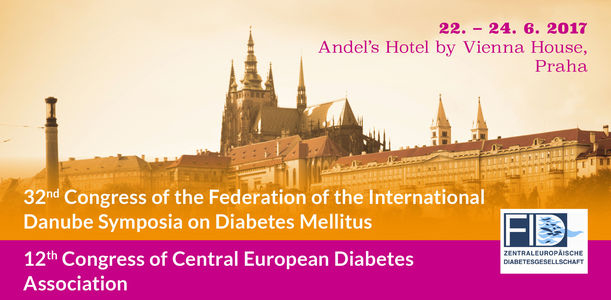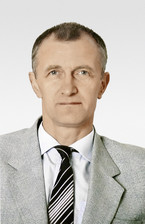32nd Congress of the Federation of the International Danube Symposia on Diabetes mellitus/12th Congress of the Central European Diabetes Association
The 32nd Congress of the Federation of the International Danube Symposia (FID) and 12th Congress of the Central European Diabetes Association (CEDA) were organized in June 22 – 24, 2017 in Prague, Czech Republic. It was just twenty years later, when the 14th FID Donau Symposium was held in Prague as well.
This year the meeting was smaller with around 100 participants and a total of 55 presentations introducing actual topics in different fields in diabetes. The program contained 32 lectures of invited speakers and 23 posters.
Antidiabetic drugs and their effects
In the first session entitled "Antidiabetic drugs – Decisions for modern treatment" Ivan Tkáč (Slovakia) showed the possible application of pharmacogenomics into treatment of type 2 diabetes mellitus. Christoph Wanner (Germany) analyzed the benefits of empagliflozin on the progression of albuminuria and renal failure in the recent clinical trial EMPA-REG OUTCOME. This study could demonstrate renoprotection besides cardioprotective effects described earlier. Ilse Konrade (Latvia) summarized the positive effects of metformin not only in association with diabetes but in other clinical situations.
Diagnostic problems in diabetes
The second session was entitled "The way to proper diagnosis". Nanette Schloot (Germany) described actual problems with classification of diabetes and its significance for proper diabetes treatment. Štěpánka Průhová (Czech Republic) introduced the present status with diagnosis of maturity onset diabetes of the young (MODY) in the Czech Republic. Ondřej Cinek (Czech Republic) analyzed experience and his own data with viruses and bacteria as a compound of intestinal microbioma in the relationship to development of type 1 diabetes. Finally, Jan Škrha presented data of his 37 years experience with diagnosis and treatment of non-diabetic hypoglycaemia, including organic hyperinsulinism.
The program of the first day was closed by the symposium sponsored by Boehringer Ingelheim. Martin Prázný (Czech Republic) summarized cardiovascular effects of empagliflozin and Heinz Drexel (Austria) presented actual recommendations based on the new findings with gliflozins.
Inter-organ relationships
The next day started with physiological regulation and inter-organ relationships entitled "The main players in metabolic regulations". Michael Roden (Germany) introduced actual findings in metabolic relationships between the muscle, liver and adipose tissue which have an important influence on insulin sensitivity. Martin Haluzík reported regulations originating from gastrointestinal hormones and their clinical utility in the treatment of diabetes. Erifili Hatziagelaki (Greece) analyzed the role of liver diseases, especially of non-alcoholic fatty liver disease (NAFLD) and non-alcoholic steatohepatitis (NASH), and their influence on the diabetes control. Markolf Hanefeld (Germany) mentioned the clinical significance of the frailty in older patients as an important factor for individualization of the treatment.
Details of atherosclerosis
Complications in diabetes entitled "Pavement to vascular disease" were opened by Peter Nawroth (Germany) who discussed the role of fibrosis in the connective tissue as an important morphology in development of chronic vascular disease. Jan Škrha jr. (Czech Republic) mentioned biomarkers, especially microRNA, which could be used as early markers of vascular changes in diabetes. Kateřina Kaňková (Czech Republic) elucidated some indicators of diabetic kidney disease and demonstrated changes in the thiamin metabolism and the role of transketolase in renal pathology. Helmut Schatz (Germany) highlighted the news in dyslipidaemia in the development of atherosclerosis.
Diabetes control during physical activity
In the lunch symposium sponsored by Medtronic Tomasz Klupa (Poland) showed the important role of physical activity in diabetes control maintained by insulin pumps and its monitoring in extreme conditions. He also invited participants to the next 33rd FID congress which will be held in Krakow, June 14 – 16, 2018.
Limb complications
In the afternoon the first session was entitled "Neural tissue and wounds – targets for treatment". Péter Kempler (Hungary) elucidated pathophysiology in close relationship of neuropathy and vascular changes in diabetes and its clinical consequences. In the next lecture Dan Ziegler (Germany) mentioned the actual possibilities in the drug treatment of diabetic neuropathy. Robert Bém and Michal Dubský (Czech Republic) introduced the stem cells as possible way in the treatment of diabetic wounds and critical ischaemia of the lower limbs.
Glucose variability and continuous glucose monitoring
New technologies entitled "Technologies – promising dreams and reality" were introduced by Roman Hovorka (United Kingdom) who demonstrated the actual development in the closed loop systems covering insulin pumps and continuous glucose monitoring including the use of bihormonal infusion (insulin and glucagon). Martin Prázný (Czech Republic) spoke about glucose variability as an important factor which should be monitored in insulin treated diabetic patients. In the following lecture Zdeněk Šumník (Czech Republic) described the care for diabetic children in the Czech Republic including the register "Čenda". Jan Šoupal reviewed own results with the continuous glucose monitoring in type 1 diabetic patients on insulin pumps and pens.
In the evening symposium sponsored by Eli Lilly Kateřina Štechová (Czech Republic) discussed innovations in insulin treatment, and Martin Haluzík (Czech Republic) spoke about the necessity of properly selected patients on GLP-1 receptor agonists.
Transplantation therapy
In the last congress day, the FID president Roger Lehmann (Switzerland) introduced the session "How to substitute disturbed function in diabetes" with the β-cell replacement therapy in diabetes with detailed description of different types of transplantation. Peter Girman (Czech Republic) reported the results with transplantations in the Czech Republic. Ivan Rychlík (Czech Republic) reviewed the care for diabetic patients in dialysis centres in the Czech Republic. This session was closed by Jan Polák (Czech Republic) with a report of a sleep apnea syndrome and the needs of its early detection and treatment.
Protecting β-cells
The last session entitled "Perspectives for diabetic patients" was introduced by Eberhard Standl (Germany) who summarized firstly the view of cardiologist Anselm Gitt (Germany) who acutely could not come and sent his lecture concerning the role of new antidiabetic drugs on cardiovascular system. Eberhard Standl than continued and demonstrated that the glucocentric view in the treatment of diabetes needs to be changed and longterm cardiovascular effects of antidiabetic drugs have to be evaluated in the light of recent studies with gliflozins and GLP-1 receptor agonists. Michael Nauck (Germany) remembered in excellent review the history of incretins and their introduction in clinical practice. Possible prevention of β-cell failure summarized Michal Anděl (Czech Republic) in the final lecture.
Dynamic development of diabetology
The posters from different fields of diabetes brought additional views into the program of the symposium which confirmed dynamic development of diabetology with new changes and considerations in classification, early diagnosis of complications and proper treatment. Participants from 11 countries created very active discussions during the entire symposium. The cordial atmosphere was filled by the get-together dinner in the modern "Dancing house" (called Ginger and Fred) built in the early nineties of the last century.
Erschienen in: Diabetes, Stoffwechsel und Herz, 2017; 26 (5) Seite 296-298


